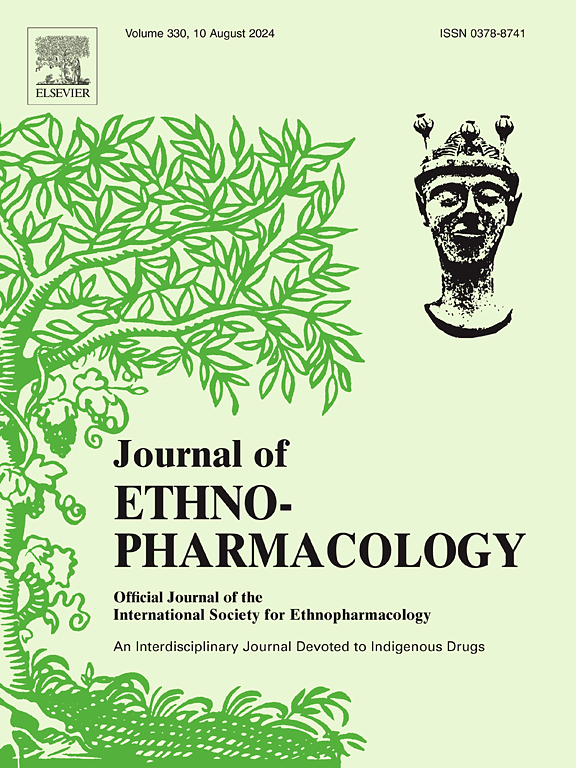Rubia cordifolia L. extract ameliorates vitiligo by inhibiting the CXCL10/CXCL9/STAT1 signaling pathway
IF 4.8
2区 医学
Q1 CHEMISTRY, MEDICINAL
引用次数: 0
Abstract
Ethnopharmacological relevance
Rubia cordifolia L. (RCL) is a traditional herbal medicine with a long history of use. It has been employed to treat conditions such as abnormal uterine bleeding, primary dysmenorrhea, allergic purpura, eczema, and psoriasis. In Uyghur traditional medicine, it is also utilized to manage vitiligo, tinea, skin scars, and inflammatory wounds. However, the precise mechanism through which RCL improves vitiligo is still not fully understood.
Aim of the study
This research sought to examine the therapeutic impacts of RCL on vitiligo, determine whether its effects on the progression of vitiligo are facilitated via the CXCL10/CXCL9/STAT1 pathway, and perform an analysis of the chemical composition along with the identification of RCL.
Materials and methods
Chemical composition identification of RCL extract was performed using UHPLC-QTOF-MS/MS. A mouse model of vitiligo was created to assess the therapeutic effectiveness of RCL by analyzing the expression of CD8+ T cells, performing HE staining, conducting melanin staining, evaluating TYR activity, and measuring the levels of inflammatory cytokines. Transcriptomic and metabolomic analyses were conducted to explore the mechanisms underlying RCL-mediated improvement of vitiligo.
Results
A total of 156 compounds were identified in RCL, predominantly including anthraquinones, naphthoquinones, and terpenoids. RCL treatment significantly reduced CD8+ T cell expression, downregulated expression of cytokines that promote inflammation, and upregulated TYR activity and melanin production. Transcriptomic and metabolomic analyses identified the CXCL10/CXCL9/STAT1 signaling pathway and the metabolism of lysophosphatidylcholine and leukotriene B4 as key mechanisms underlying RCL's therapeutic effects on vitiligo, indicating that RCL ameliorates vitiligo by modulating autoimmunity and attenuating inflammatory responses. Western blotting and qPCR further validated that RCL inhibits the production of proteins linked to the CXCL10/CXCL9/STAT1 axis, including CXCL10, CXCL9, STAT1, and CXCR3. Additionally, RCL reduced the expression of inflammatory markers such as IL-1RAP, IL-6, IL-17A, KNG1, and PLA2G4E, further supporting its anti-inflammatory and immunoregulatory properties.
Conclusions
Our study demonstrates that RCL ameliorates the progression of vitiligo by modulating autoimmunity and attenuating inflammatory responses. The underlying mechanisms may involve mediating the CXCL10/CXCL9/STAT1 axis and regulating lysophosphatidylcholine and leukotriene B4 metabolism.
rubbia cordifolia L.提取物通过抑制CXCL10/CXCL9/STAT1信号通路改善白癜风
与民族药理学的关系甘草(RCL)是一种具有悠久使用历史的传统草药。它已被用于治疗条件,如异常子宫出血,原发性痛经,过敏性紫癜,湿疹和牛皮癣。在维吾尔族传统医学中,它也被用来治疗白癜风、癣、皮肤疤痕和炎症性伤口。然而,RCL改善白癜风的确切机制尚不完全清楚。本研究旨在探讨RCL对白癜风的治疗作用,确定其对白癜风进展的影响是否通过CXCL10/CXCL9/STAT1通路促进,并在确定RCL的同时进行化学成分分析。材料与方法采用UHPLC-QTOF-MS/MS对RCL提取物进行化学成分鉴定。建立白癜风小鼠模型,通过分析CD8+ T细胞表达、HE染色、黑色素染色、评价TYR活性、测定炎性细胞因子水平来评估RCL治疗白癜风的效果。转录组学和代谢组学分析探讨了rcl介导的白癜风改善的机制。结果共鉴定出156种化合物,主要为蒽醌类、萘醌类和萜类化合物。RCL治疗显著降低CD8+ T细胞表达,下调促炎细胞因子表达,上调TYR活性和黑色素生成。转录组学和代谢组学分析发现,CXCL10/CXCL9/STAT1信号通路以及lysophatidycholine和白三烯B4的代谢是RCL治疗白癜风的关键机制,表明RCL通过调节自身免疫和减轻炎症反应来改善白癜风。Western blotting和qPCR进一步证实,RCL抑制CXCL10/CXCL9/STAT1轴相关蛋白的产生,包括CXCL10、CXCL9、STAT1和CXCR3。此外,RCL降低炎症标志物如IL-1RAP、IL-6、IL-17A、KNG1和PLA2G4E的表达,进一步支持其抗炎和免疫调节特性。结论研究表明RCL通过调节自身免疫和减轻炎症反应来改善白癜风的进展。潜在的机制可能涉及介导CXCL10/CXCL9/STAT1轴和调节溶血磷脂酰胆碱和白三烯B4代谢。
本文章由计算机程序翻译,如有差异,请以英文原文为准。
求助全文
约1分钟内获得全文
求助全文
来源期刊

Journal of ethnopharmacology
医学-全科医学与补充医学
CiteScore
10.30
自引率
5.60%
发文量
967
审稿时长
77 days
期刊介绍:
The Journal of Ethnopharmacology is dedicated to the exchange of information and understandings about people''s use of plants, fungi, animals, microorganisms and minerals and their biological and pharmacological effects based on the principles established through international conventions. Early people confronted with illness and disease, discovered a wealth of useful therapeutic agents in the plant and animal kingdoms. The empirical knowledge of these medicinal substances and their toxic potential was passed on by oral tradition and sometimes recorded in herbals and other texts on materia medica. Many valuable drugs of today (e.g., atropine, ephedrine, tubocurarine, digoxin, reserpine) came into use through the study of indigenous remedies. Chemists continue to use plant-derived drugs (e.g., morphine, taxol, physostigmine, quinidine, emetine) as prototypes in their attempts to develop more effective and less toxic medicinals.
 求助内容:
求助内容: 应助结果提醒方式:
应助结果提醒方式:


